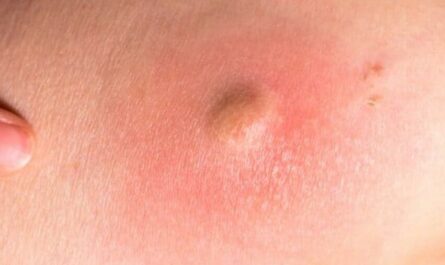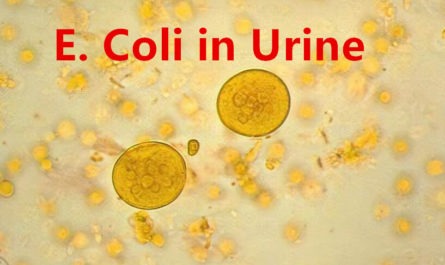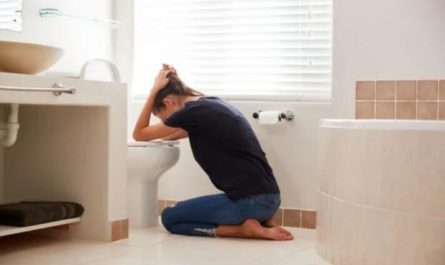Having itchy feet can be a frustrating and uncomfortable experience, particularly when it happens consistently, especially at night. If you’ve ever dealt with this issue, you know how it can interfere with your sleep and daily activities. In this article, we will delve into why your feet itch, particularly during the nighttime. In addition, we will offer some home remedies to help you relieve the itch.
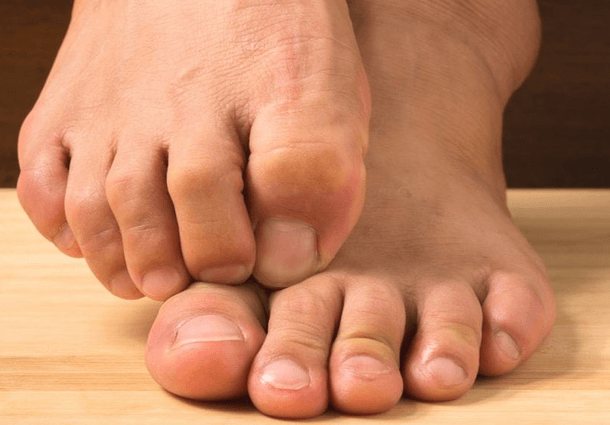
Cause of Itchy Feet at Night
Itchy feet at night can often be annoying, especially when trying to fall asleep! Many do not know why itching is more severe at night than during the day.
This is due to the natural mechanism of the body. At night, the blood flowing to your skin will increase. This will increase your skin temperature and make you feel itchy. At the same time, the body releases more cytokines which will increase inflammation. Also, your skin will lose more moisture in the evening, which leads to dry skin.
In addition, work and other activities during the day can distract you and make the brain not notice itch at all. At night, distraction is less, leading to more intense itchy feet.
In addition to the natural causes of physical mechanisms, many factors cause your feet to itch constantly.
10 Common Causes of Feet Itch All The Time
1. The Athlete’s Foot
The athlete’s foot, also known as tinea pedis, is a common fungal infection on the bottom of the feet or between the toes. It is the most common cause of itching or itchy feet, especially at night. Don’t just look at the name, the athlete’s feet do not just happen to athletes. Everyone may experience this condition.
Athletes’ foot usually occurs in dark, moist environments such as closed shoes and socks. This provides a perfect environment for the growth of fungi. In addition, dressing rooms, swimming pools, and showers are also vulnerable to tinea pedis.
The athlete’s foot is contagious and usually, be spread by sharing towels and unclean pedicure devices. It may cause the skin to become red, swollen, itchy, tingling, burning, and feels like a “foot on fire.” In addition, moist, raw skin, scales, and rashes may appear between the toes.
You can use topical antifungal medication to get rid of the athlete’s foot. However, prevention is always the best treatment. For example, use antibacterial soap every day to wash your feet. After bathing or bathing, wipe off as soon as possible. Wear breathable shoes and change your socks often, especially after exercise. Avoid using shower shoes in public showers.
2. Eczema
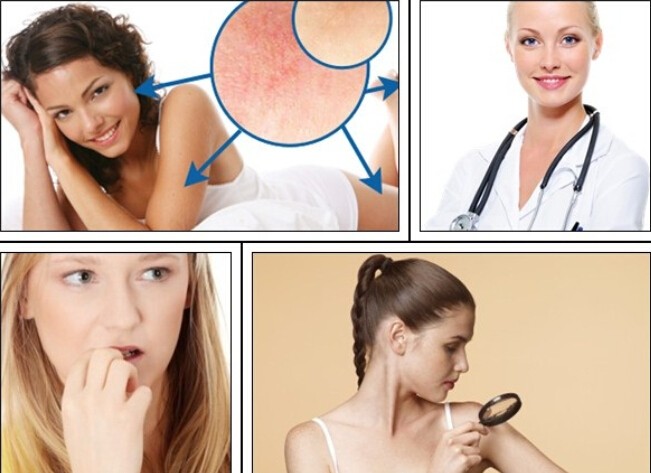
Eczema is not a specific health condition; it is often a response to other diseases. This is a common cause of itchy feet at night. Many different types of eczema can occur anywhere in the body. One is called dyshidrotic dermatitis, which usually affects only the hands and feet.
Dyshidrotic dermatitis can cause a rash, itching, redness, and scaly skin on the feet. You can notice elevated plaque and blisters filled with clear liquid, usually lasting 2-4 weeks.
A wet environment generally causes Dyshidrotic dermatitis. In addition, other factors such as seasonal allergies, exposure to chemicals, and long-term stress can also cause dyshidrotic eczema.
For mild eczema, the ointment can be used to relieve itching. You may need to see a doctor to eliminate inflammation for severe eczema by using steroids, antihistamines, and antibiotics.
3. Contact Dermatitis
Did you ever experience redness, itching, and irritation on the skin after using a new product or detergent? This may be the symptom of contact dermatitis.
Contact dermatitis is often caused by exposure to irritating toxic substances or an allergic reaction to certain substances. These substances include soaps, cosmetics, latex gloves, perfumes, jewelry, poison oak, poison ivy, and chemicals found in footwear.
Contact dermatitis can cause extreme itching, swelling, burning, redness, rash, and dry, scaly skin. In addition, you may also notice watery or crusted blisters. Fortunately, most contact dermatitis is not serious and not contagious, but it can be very uncomfortable.
The best way to treat contact dermatitis is to avoid the substance that caused it. In this situation, the rash usually disappears within 2 to 4 weeks. You can clean your feet’ skin with mild soap to remove irritants and apply a cool compress to the affected area. Last, apply Vaseline to soothe the area.
You can also use anti-itch treatments such as calamine lotion or hydrocortisone cream to relieve the symptoms. However, if the rash is huge, you need to see a doctor for treatment with an oral antihistamine drug to reduce the allergic response.
4. Psoriasis
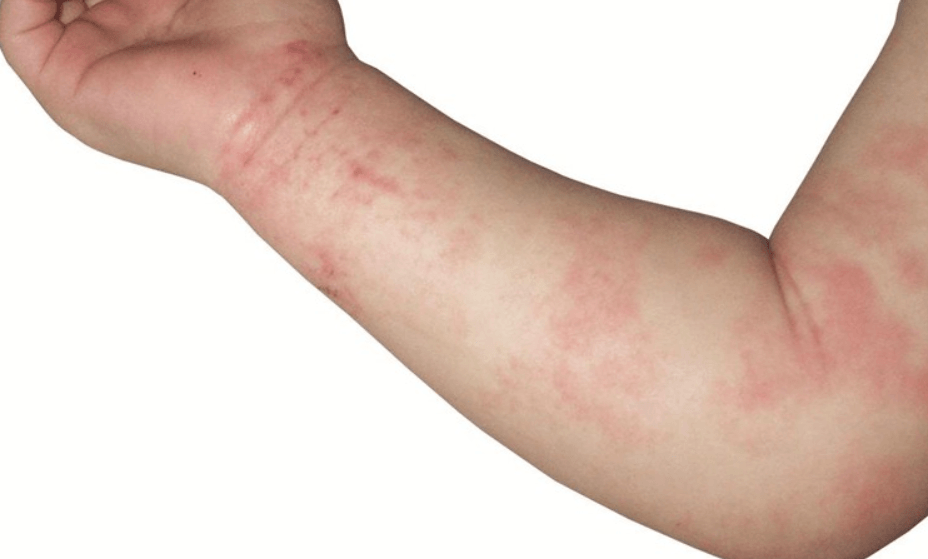
Psoriasis is a common chronic skin disease that occurs when skin cells grow too fast on the skin’s surface. This condition can cause skin cells to accumulate on the skin and form red patches or bumps filled with silver scales.
You may feel burning, swelling, stiff joints, and itchy soles of your feet at night. Psoriasis usually causes severe itching of the soles of the feet and soreness of the affected area. You may also notice pitted, ridged, or thickened feet nails.
The cause of psoriasis is unknown yet, but many studies have shown it is related to infections, colds, stress, and problems with the immune system.
A common method of treating psoriasis is to use a topical ointment, phototherapy, and drugs to prevent the rapid growth of skin cells. In addition, you can also change your lifestyle to reduce symptoms such as moisturizing, quitting smoking, and reducing stress.
5. Scabies
Scabies is a contagious skin infection caused by mites. The mites will burrow deep into the skin and lay eggs. This will lead to severe skin itching and a red rash. The itching sensation usually worsens at night.
In addition, severe skin itching can lead to frequent scratches, aggravating skin infections. In severe cases, you will notice small blisters and tiny Grayish-white burrow tracks on the skin.
This symptom is more common in children, and it usually appears on the palms, the neck, the scalp, the face, and the soles of the feet. Scabies usually appears between the breasts, armpits, elbows, wrists, fingers, and toes in adults.
Scabies is a highly contagious skin disease that can spread rapidly through direct skin-to-skin contact. In addition, sexual contact can also lead to the spread of scabies.
You can only kill worms and eggs with drugs such as acaricides and other products to treat scabies. Home remedies or over-the-counter remedies are ineffective at eliminating scions.
6. Dry Skin
Dry skin is a very common condition, especially during the cold winter months. People with diabetes, low immunity, or a history of eczema are more likely to suffer from this condition. Although this is not a dangerous condition, it can make you uncomfortable.
Dry skin can cause redness, dryness, itching, cracks, and even bleeding. You may be uncontrollable to scratch, which may cause the skin to become thicker and darker. At the same time, it may cause many complications, such as skin rashes, eczema, and bacterial infections.
The common cause of dry skin on the feet is unsuitable shoes and other diseases such as athlete’s foot, psoriasis, diabetes, thyroid disease, etc.
Usually, you can relieve the itching by using topical corticosteroids and creams. Lotions often contain alcohol which will worsen dry skin. In addition, you can try some home remedies to prevent dry skin, such as choosing more comfortable shoes, exfoliating with a pumice stone, and applying moisturizer.
7. Diabetes

Sometimes, the itching of the feet, legs, or ankles may be a sign of diabetes, especially if there are other symptoms of diabetes. Moreover, some complications of diabetes, such as nerve damage or kidney disease, can also cause itching of the arms, legs, and feet.
Long-term high blood sugar can lead to redness and small yellow bumps on the skin. Other symptoms of diabetes include frequent urination, extreme hunger, blurred vision, skin infections, and unexplained weight loss.
Insulin is the main treatment for controlling blood sugar. In addition, you can use diet and exercise methods to eliminate the itching caused by diabetes.
8. Bug Bites or Stings
In warm weather, many people like to wear shorts and sandals, which will expose the skin of the feet and ankles to insects. Bugs like ants, bees, mosquitoes, wasps, spiders, and fleas can cause bites and stings.
Bug bites can cause skin redness, rash, muscle pain, swelling, itching, and blisters on the skin of the feet or legs.
Most bug bites or stings cause only minor discomfort, but some encounters can be fatal, especially if you are allergic to insect venom. In addition, many insect bites can also spread the disease.
Prevention is the best treatment. Try to avoid perfumes or scented lotions. Wear socks to protect the skin on the feet.
A slight bite can be treated at home. Wash the affected area and apply an ice pack or baking soda to relieve pain and swelling. Apply topical antipruritic cream or oral pain reliever to relieve symptoms. You need immediate medical attention if severe reactions occur, such as nausea, vomiting, difficulty breathing, rapid heartbeat, and confusion.
9. Allergic Reactions
Allergic reactions to certain substances can manifest as itching on the feet. These allergens may include specific types of footwear, socks, or laundry detergents.
Contact dermatitis is a common allergic reaction characterized by redness, itching, and inflammation. Identifying and avoiding the allergen is essential to prevent further discomfort.
10. Poor Circulation
Impaired blood flow to the feet, often due to conditions like peripheral artery disease (PAD) or diabetes, can result in itchy feet.
Reduced circulation can lead to dryness, numbness, and tingling sensations in the extremities. Managing the underlying cause of poor circulation and maintaining proper foot hygiene is crucial in managing itchiness.
How to Stop Itchy Feet at Home?
1. Baking Soda
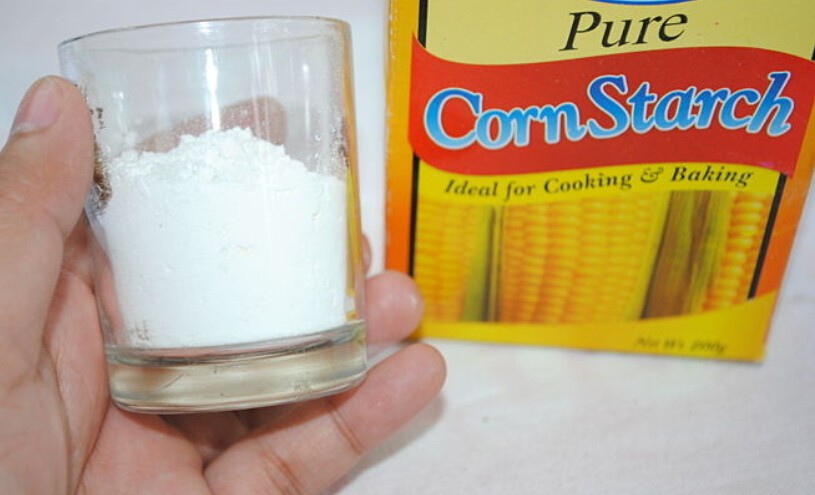
Using baking soda paste on itchy feet can effectively relieve itching and burns sensations between toes or on your feet. Moreover, it can treat fungal infections and reduce the unpleasant smell on the feet.
Add one tablespoon of baking soda to 2-3 tablespoons of water and stir to make a paste. Apply it on your feet, especially in the gap between your toes. Wait for 5 to 10 minutes and rinse with cold water. Dry your feet thoroughly with a soft towel, then apply powder to absorb moisture.
Read: 10 Health Benefits of Bath with Baking Soda
2. Saltwater Soaking
Soaking your feet with saline is another effective method to get rid of itchy feet. A saltwater soak can help soothe your feet and relieve pain, itching, or irritation.
Add 2 teaspoons of salt to a pint of warm water in the bathtub. Mix well and soak your feet in the water for 5 to 10 minutes. Ensure the water is enough to cover the top of your feet.
Repeat this process several times your itching improves. Then rinse your feet with cold water and apply a moisturizer.
3. Tea Tree Oil
Tea tree oil, distilled from the leaves of Melaleuca alternifolia, is an effective preservative to cure an athlete’s foot. It has been used to treat cuts, burns, and infections in Australia for many years.
The study found 10% tea tree oil cream can effectively relieve an athlete’s foot symptoms, such as inflammation, scaling, itching, and burning. In addition, tea tree oil was significantly more effective than placebo in treating athletes’ feet.
4. Garlic
Garlic has a compound called ejiao that has antifungal and anti-microbial properties. It can help relieve infection, itching, and pain. Crush one garlic clove and add 2 to 3 drops of olive oil.
Mix well to make a paste and apply it directly on the feet. Leave it on for 20-30 minutes and wash off with water. Finally, don’t forget to dry your skin and apply a moisturizer.
You can crush some cloves into the water, then soak your feet for about 30 minutes. Repeat this process 1-2 times a day, which can treat infections and prevent a recurrence.
In addition, you can also add garlic to your diet. This can help improve your immunity and accelerate the healing process of fungal infections.
Read: 14 Health Benefits of Eating A Garlic Clove Every Day
5. Vinegar
The acid in vinegar can help fight the fungus and inhibits skin infections. Also, vinegar can help dry your feet, speeding up your healing process.
To get athlete’s feet, mix vinegar and warm water in a ratio of 1 to 3 and soak your feet. Do this twice a day for about 10 minutes each time.
You can also apply the mixture to the affected area with cotton. Leave it on for about 10 minutes, and then rinse with cool water. In addition, you can use this mixture to wipe down the inside of the shoe to eliminate the fungus.
6. Yogurt
Yogurt contains probiotics, which can help fight fungal infections like athlete’s foot. You can apply the yogurt directly to the skin to get rid of the Itchy feet. Then let it dry and rinse with lukewarm water.
In addition, you can also eat a cup of plain yogurt every day. This can help improve your digestive function and enhance immunity. Remember to use plain yogurt, not yogurt, with added ingredients.
Read: 15 Proven Health Benefits of Yogurt on Your Body
7. Moisturize Regularly
To combat dryness and alleviate itching, it is essential to keep your feet moisturized. Apply good foot cream or lotion containing ingredients like shea butter, glycerin, or hyaluronic acid. Moisturizing your feet daily, especially after bathing, can help restore moisture and soothe the skin.
8. Use Antifungal Treatments
If you suspect you have an athlete’s foot, over-the-counter antifungal creams, sprays, or powders can effectively treat the infection. Follow the instructions and continue the treatment for the recommended duration to ensure complete fungus eradication.
9. Avoid Allergens
If you experience allergic reactions on your feet, identifying and avoiding the allergen is crucial. Opt for hypoallergenic socks, breathable footwear, and fragrance-free laundry detergents. Keeping your feet clean and dry can also minimize the risk of developing allergic reactions.
10. Practice Good Foot Hygiene
Maintaining proper foot hygiene is vital in preventing and managing itchy feet. Wash your feet daily with a mild soap, ensuring to dry them thoroughly, especially between the toes. Trim your nails regularly and wear clean, breathable socks made of natural fibers like cotton or bamboo.
FAQ
1. Is scratching the feet a good idea to relieve the itch?
Scratching the feet may provide temporary relief, but it can exacerbate the itching and potentially lead to skin damage or infections. It is advisable to avoid scratching and instead use appropriate remedies to soothe the itchiness.
2. Can changing my diet help reduce itchy feet?
A: In some cases, dietary changes may help alleviate itchy feet, particularly if the cause is related to an allergic reaction or certain medical conditions. Consulting with a healthcare professional or a registered dietitian can guide appropriate dietary modifications.
3. Should I see a doctor if other symptoms accompany my itchy feet?
Yes, it is recommended to seek medical attention if you experience additional symptoms alongside itchy feet. These symptoms may include persistent redness, swelling, pain, discharge, or fever. A healthcare professional can assess your condition comprehensively and provide appropriate treatment.

